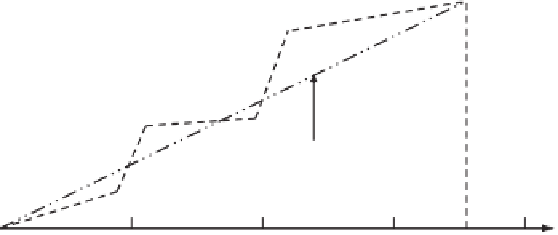Environmental Engineering Reference
In-Depth Information
moisture flow. In addition, a number of procedures have
been proposed for the calculation of the AE moisture flux;
however, there have been few studies to assess the quanti-
tative relationship between each of the suggested solution
procedures. The reliability of all proposed analytical proce-
dures has not been fully studied to assess situations under
which various analyses give reliable computations of AE.
Calculation procedures for AE can be divided into two
broad categories, namely, “moisture-flux-only” solutions
and “coupled moisture-and-heat-flow” solutions. Moisture-
flux-only solutions strictly apply when the ground surface
soil temperature is equal to the air temperature or the
ground surface temperature is calculated by some empirical
means. The coupled solution means that the moisture and
heat flow partial differential equations are solved simul-
taneously. In the moisture-flux-only solution the ground
surface soil temperature is either assumed or calculated
in an empirical manner. The ground surface temperature
becomes the boundary condition for heat flow throughout
the soil domain.
Three independent calculation procedures for AE have
been used in geotechnical engineering applications: (i) the
“limiting function” equation proposed by Wilson et al.
(1997a), (ii) the Wilson-Penman equation, (Wilson et al.
1994), and (iii) the “experimental-based” equation proposed
by Wilson et al. (1997a). Each of the three methodologies
can be solved in a coupled or uncoupled manner. This
gives rise to six possible procedures for the calculation of
AE
,
as illustrated in Fig. 6.13.
The solution procedures involve varying amounts of input
detail and calculation rigor. The advantages and disadvan-
tages of each of the calculation procedures have not been
fully studied to assess their applicability in geotechnical
engineering practice. The components associated with heat
and moisture flux boundary can be independently studied.
Then procedures can be considered for the formulation of
coupled and uncoupled solutions.
6.3.5 Precipitation (Rainfall and Snowfall)
Precipitation can take the form of rainfall and snowfall. The
magnitude of precipitation must be measured at or near
the site under consideration. Temperature, relative humid-
ity, wind speed, and rainfall are the basic variables usually
measured on an elementary weather station. Daily precipi-
tation measurements may have been recorded over a period
of many years.
The precipitation data for each year can be considered
as an independent record and used as such for analysis
purposes. A cumulative annual precipitation record can be
plotted for each year (Fig. 6.14). The cumulative annual
precipitation provides information on the distribution of pre-
cipitation within each year, as shown in Fig. 6.14. Two
differing scenarios are shown: one scenario that shows an
even distribution of precipitation throughout the year and
Calculation of AE
Wilson-Penman Eq.
Limiting function Eq.
Experimental-based Eq.
Coupled
Uncoupled
Coupled
Uncoupled
Coupled
Uncoupled
Figure 6.13
Possible coupled and uncoupled solutions to compute AE.
Total average
precipitation
Second
rainy season
First rainy
season
Uniformly distribution annual
precipitation
0
100
200
300
365
400
Typical year, days
Figure 6.14
Effect of variation in precipitation distribution throughout year.
















Search WWH ::

Custom Search